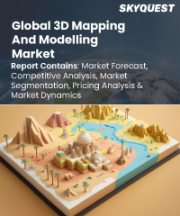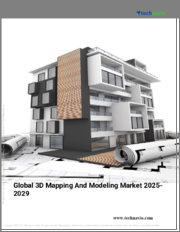
|
시장보고서
상품코드
1733082
세계의 3D 모델링, 3D 시각화, 3D 데이터 캡처 시장 조사 보고서 : 산업 분석, 규모, 점유율, 성장, 동향, 예측(2025-2033년)Global 3D Modeling, 3D Visualization, and 3D Data Capture Market Research Report- Industry Analysis, Size, Share, Growth, Trends and Forecast 2025 to 2033 |
||||||
세계의 3D 모델링, 3D 시각화, 3D 데이터 캡처 시장 규모는 2024년 8억 9,557만 달러에서 2033년에는 12억 8,819만 달러로 성장하며, 2026-2033년의 예측 기간 중 4.12%의 견고한 연평균 성장률(CAGR)을 보일 것으로 예측됩니다.
3D 모델링, 3D 시각화, 3D 데이터 캡처 시장은 기술 발전과 다양한 산업 분야의 몰입형 경험에 대한 수요 증가에 힘입어 전례 없는 성장세를 보이고 있습니다. 기업이 제품 디자인, 마케팅, 고객 참여를 강화하기 위해 3D 기술을 채택하는 것은 필수적인 요소가 되고 있습니다. 이러한 툴을 통해 조직은 제품과 환경을 사실적으로 표현하고 더 나은 의사결정과 협업을 촉진할 수 있습니다. 가상현실(VR)과 증강현실(AR)을 3D 모델링 및 시각화 프로세스에 통합하면 사용자 경험을 더욱 향상시키고, 청중을 사로잡는 인터랙티브하고 매력적인 프레젠테이션을 만들 수 있습니다.
또한 건축, 건설, 게임 등의 산업이 부상하면서 고급 3D 데이터 캡처 솔루션에 대한 수요가 증가하고 있습니다. 프로젝트가 복잡해짐에 따라 물리적 공간을 정확하고 상세하게 표현해야 할 필요성이 가장 커지고 있습니다. 레이저 스캐닝 및 사진 측량과 같은 기술은 데이터 수집 및 활용 방식에 혁명을 일으켜 전문가들이 실제 상황을 반영하는 정확한 3D 모델을 생성할 수 있게 해줍니다. 점점 더 많은 기업이 프로젝트 성과를 개선하고 워크플로우를 간소화하기 위해 3D 데이터 캡처에 의존하고 있으므로 이러한 추세는 시장을 발전시킬 것으로 예측됩니다.
또한 디지털 트윈에 대한 관심이 높아지면서 3D 모델링 및 시각화 시장의 미래가 형성되고 있습니다. 물리적 자산의 가상 복제본인 디지털 트윈을 통해 조직은 실시간으로 성능을 모니터링하고 분석할 수 있습니다. 이 기능은 운영 최적화가 중요한 제조 및 물류와 같은 산업에서 특히 유용하게 활용될 수 있습니다. 디지털 트윈의 개념이 확산됨에 따라 혁신을 촉진하고 효율성과 경쟁력을 향상시키기 위해 데이터의 잠재력을 최대한 활용할 수 있는 고급 3D 모델링 및 시각화 툴에 대한 수요는 계속 증가할 것입니다.
당사의 보고서는 고객에게 다양한 산업 및 시장에 대한 종합적이고 실용적인 인사이트를 제공하기 위해 세심하게 작성되었습니다. 각 보고서는 시장 상황을 완전히 이해하기 위해 몇 가지 중요한 요소를 포함하고 있습니다.
시장 개요: 시장에 대한 자세한 소개로 정의와 분류, 그리고 업계 현황에 대한 개요를 설명합니다.
시장 성장 촉진요인 : 시장 성장에 영향을 미치는 주요 촉진요인, 억제요인, 시장 성장 촉진요인 및 과제를 상세하게 분석합니다. 이 섹션에서는 기술 발전, 규제 변화, 새로운 동향 등의 요인을 검토합니다.
세분화 분석 : 제품 유형, 애플리케이션, 최종사용자, 지리 등의 기준에 따라 시장을 명확한 부문으로 분류합니다. 이 분석을 통해 각 부문의 성과와 잠재력을 파악할 수 있습니다.
경쟁 환경: 주요 시장 기업에 대한 시장 점유율, 제품 포트폴리오, 전략적 노력, 재무 성과 등을 종합적으로 평가합니다. 주요 기업이 채택하고 있는 경쟁 역학 및 주요 전략에 대한 인사이트을 제공합니다.
시장 예측 : 과거 데이터와 현재 시장 상황을 바탕으로 일정 기간 중 시장 규모와 성장 추세를 예측합니다. 여기에는 정량적 분석과 미래 시장 궤적을 보여주는 그래프 표시가 포함됩니다.
지역 분석 : 지역별 시장 성과를 평가하고 주요 시장 및 지역 동향을 파악할 수 있습니다. 지역 시장 역학 및 비즈니스 기회를 이해하는 데 도움이 됩니다.
새로운 동향과 기회 : 현재 시장 동향과 새로운 시장 동향, 기술 혁신, 잠재적 투자 대상 분야를 파악합니다. 미래 시장 개발 및 성장 전망에 대한 인사이트를 제공합니다.
목차
제1장 서문
제2장 개요
- 시장의 하이라이트
- 세계 시장 스냅숏
제3장 3D 모델링, 3D 시각화, 3D 데이터 캡처 업계 분석
- 서론 : 시장 역학
- 시장 성장 촉진요인
- 시장 성장 억제요인
- 시장 기회
- 업계 동향
- Porter's Five Forces 분석
- 시장의 매력 분석
제4장 밸류체인 분석
- 밸류체인 분석
- 원재료 분석
- 원재료 리스트
- 원재료 제조업체 리스트
- 주요 원재료의 가격 동향
- 잠재적 바이어 리스트
- 마케팅 채널
- 다이렉트 마케팅
- 인다이렉트 마케팅
- 마케팅 채널 발전 동향
제5장 세계의 3D 모델링, 3D 시각화, 3D 데이터 캡처 시장 분석 : 시각화 용도별
- 개요
- 과거 및 예측 데이터 분석
- AR & VR(트레이닝, 마케팅 등)
- 안전 & 트레이닝
- 마케팅 & 세일즈 애니메이션
- 포스트 프로덕션
- 제품·프로세스
- 운송
제6장 세계의 3D 모델링, 3D 시각화, 3D 데이터 캡처 시장 분석 : 솔루션별
- 개요
- 과거 및 예측 데이터 분석
- 3D CAD 모델링
- 3D BIM 모델링
제7장 세계의 3D 모델링, 3D 시각화, 3D 데이터 캡처 시장 분석 : 용도별
- 개요
- 과거 및 예측 데이터 분석
- 구조 설계
- 통합 해석과 매트리얼·테이크 오프 리포트
- 설비 설계
- 설비 모델링
- 지능형 그리드
제8장 세계의 3D 모델링, 3D 시각화, 3D 데이터 캡처 시장 분석 : 캡처 용도별
- 개요
- 과거 및 예측 데이터 분석
- 3D 레이저 스캐너(정적)
- 3D 핸드헬드 스캐너
- 3D 에어리얼 스캐닝
- 센서
제9장 세계의 3D 모델링, 3D 시각화, 3D 데이터 캡처 시장 분석 : 지역별
- 지역별 전망
- 서론
- 북미의 판매 분석
- 개요, 실적과 예측
- 북미 : 부문별
- 북미 국가별
- 미국
- 캐나다
- 멕시코
- 유럽의 판매 분석
- 개요, 실적과 예측
- 유럽 부문별
- 유럽 국가별
- 영국
- 프랑스
- 독일
- 이탈리아
- 러시아
- 기타 유럽
- 아시아태평양의 판매 분석
- 개요, 실적과 예측
- 아시아태평양 부문별
- 아시아태평양 국가별
- 중국
- 인도
- 일본
- 한국
- 호주
- 동남아시아
- 기타 아시아태평양
- 라틴아메리카의 판매 분석
- 개요, 실적과 예측
- 라틴아메리카 부문별
- 라틴아메리카 국가별
- 브라질
- 아르헨티나
- 페루
- 칠레
- 기타 라틴아메리카
- 중동 및 아프리카의 판매 분석
- 개요, 실적과 예측
- 중동 및 아프리카 부문별
- 중동 및 아프리카 국가별 리스트
- 사우디아라비아
- 아랍에미리트
- 이스라엘
- 남아프리카공화국
- 기타 중동 및 아프리카
제10장 3D 모델링, 3D 시각화, 3D 데이터 캡처 기업의 경쟁 구도
- 3D 모델링, 3D 시각화, 3D 데이터 캡처 시장의 경쟁
- 제휴/협력/합의
- 합병·인수
- 신제품 발표
- 기타 개발
제11장 기업 개요
- 상위 기업의 시장 점유율 분석
- 시장 집중도
- AAM Pty Ltd.
- AVEVA Group Plc
- Bentley Systems Incorporated
- EON Reality
- Esri Canada
- Goontech
- ImageMaker Advertising Inc.
- Hexagon AB
- JP Global Digital
- Solid Terrain Modeling Inc.
- Scantech(Hangzhou) Co Ltd.
- CyberOptics Corporation
Global 3D Modeling, 3D Visualization, and 3D Data Capture Market size is anticipated to grow from USD 895.57 Million in 2024 to USD 1288.19 Million by 2033, showcasing a robust Compound Annual Growth Rate (CAGR) of 4.12% during the forecast period of 2026 to 2033.
The market for 3D modeling, 3D visualization, and 3D data capture is experiencing unprecedented growth, fueled by advancements in technology and the increasing demand for immersive experiences across various industries. As businesses seek to enhance product design, marketing, and customer engagement, the adoption of 3D technologies is becoming essential. These tools enable organizations to create realistic representations of products and environments, facilitating better decision-making and collaboration. The integration of virtual reality (VR) and augmented reality (AR) into 3D modeling and visualization processes is further enhancing the user experience, allowing for interactive and engaging presentations that captivate audiences.
Moreover, the rise of industries such as architecture, construction, and gaming is driving the demand for sophisticated 3D data capture solutions. As projects become more complex, the need for accurate and detailed representations of physical spaces is paramount. Technologies such as laser scanning and photogrammetry are revolutionizing the way data is captured and utilized, enabling professionals to create precise 3D models that reflect real-world conditions. This trend is expected to propel the market forward, as organizations increasingly rely on 3D data capture to improve project outcomes and streamline workflows.
In addition, the growing emphasis on digital twins is shaping the future of the 3D modeling and visualization market. Digital twins, which are virtual replicas of physical assets, allow organizations to monitor and analyze performance in real-time. This capability is particularly valuable in industries such as manufacturing and logistics, where optimizing operations is critical. As the concept of digital twins gains traction, the demand for advanced 3D modeling and visualization tools will continue to rise, driving innovation and enabling organizations to harness the full potential of their data for improved efficiency and competitiveness.
Our reports are meticulously crafted to provide clients with comprehensive and actionable insights into various industries and markets. Each report encompasses several critical components to ensure a thorough understanding of the market landscape:
Market Overview: A detailed introduction to the market, including definitions, classifications, and an overview of the industry's current state.
Market Dynamics: In-depth analysis of key drivers, restraints, opportunities, and challenges influencing market growth. This section examines factors such as technological advancements, regulatory changes, and emerging trends.
Segmentation Analysis: Breakdown of the market into distinct segments based on criteria like product type, application, end-user, and geography. This analysis highlights the performance and potential of each segment.
Competitive Landscape: Comprehensive assessment of major market players, including their market share, product portfolio, strategic initiatives, and financial performance. This section provides insights into the competitive dynamics and key strategies adopted by leading companies.
Market Forecast: Projections of market size and growth trends over a specified period, based on historical data and current market conditions. This includes quantitative analyses and graphical representations to illustrate future market trajectories.
Regional Analysis: Evaluation of market performance across different geographical regions, identifying key markets and regional trends. This helps in understanding regional market dynamics and opportunities.
Emerging Trends and Opportunities: Identification of current and emerging market trends, technological innovations, and potential areas for investment. This section offers insights into future market developments and growth prospects.
SEGMENTATION COVERED IN THE REPORT
By Visualization Application
- AR & VR (Training, Marketing, etc)
- Safety & Training
- Marketing & Sales Animation
- Post Production
- Product & Process
- Transportation
By Solution
- 3D CAD Modeling
- 3D BIM Modeling
By Application
- Structural Designing
- Integrated Analysis & Material Take-off Reports
- Equipment Designing
- Equipment Modeling
- Intelligent Grids
By Capturing Application
- 3D Laser Scanning (Static)
- 3D Handheld Scanners
- 3D Aerial Scanning
- Sensors
- COMPANIES PROFILED
- AAM Pty Ltd.
- AVEVA Group plc
- Bentley Systems Incorporated
- EON Reality
- Esri Canada
- Goontech
- ImageMaker Advertising Inc.
- Hexagon AB
- JP Global Digital
- Solid Terrain Modeling Inc.
- Scantech (Hangzhou) Co Ltd.
- CyberOptics Corporation.
- The above list can be customized.
TABLE OF CONTENTS
1. PREFACE
- 1.1. Report Description
- 1.1.1 Objective
- 1.1.2 Target Audience
- 1.1.3 Unique Selling Proposition (USP) & offerings
- 1.2. Research Scope
- 1.3. Research Methodology
- 1.3.1 Market Research Process
- 1.3.2 Market Research Methodology
2. EXECUTIVE SUMMARY
- 2.1. Highlights of Market
- 2.2. Global Market Snapshot
3. 3D MODELING, 3D VISUALIZATION, AND 3D DATA CAPTURE INDUSTRY ANALYSIS
- 3.1. Introduction - Market Dynamics
- 3.2. Market Drivers
- 3.3. Market Restraints
- 3.4. Opportunities
- 3.5. Industry Trends
- 3.6. Poerter's Five Force Analysis
- 3.7. Market Attractiveness Analysis
- 3.7.1 Market Attractiveness Analysis By Visualization Application
- 3.7.2 Market Attractiveness Analysis By Solution
- 3.7.3 Market Attractiveness Analysis By Application
- 3.7.4 Market Attractiveness Analysis By Capturing Application
- 3.7.5 Market Attractiveness Analysis By Region
4. VALUE CHAIN ANALYSIS
- 4.1. Value Chain Analysis
- 4.2. Raw Material Analysis
- 4.2.1 List of Raw Materials
- 4.2.2 Raw Material Manufactures List
- 4.2.3 Price Trend of Key Raw Materials
- 4.3. List of Potential Buyers
- 4.4. Marketing Channel
- 4.4.1 Direct Marketing
- 4.4.2 Indirect Marketing
- 4.4.3 Marketing Channel Development Trend
5. GLOBAL 3D MODELING, 3D VISUALIZATION, AND 3D DATA CAPTURE MARKET ANALYSIS BY VISUALIZATION APPLICATION
- 5.1. Overview By Visualization Application
- 5.2. Historical and Forecast Data Analysis By Visualization Application
- 5.3. AR & VR (Training, Marketing, etc) Historic and Forecast Sales By Regions
- 5.4. Safety & Training Historic and Forecast Sales By Regions
- 5.5. Marketing & Sales Animation Historic and Forecast Sales By Regions
- 5.6. Post Production Historic and Forecast Sales By Regions
- 5.7. Product & Process Historic and Forecast Sales By Regions
- 5.8. Transportation Historic and Forecast Sales By Regions
6. GLOBAL 3D MODELING, 3D VISUALIZATION, AND 3D DATA CAPTURE MARKET ANALYSIS BY SOLUTION
- 6.1. Overview By Solution
- 6.2. Historical and Forecast Data Analysis By Solution
- 6.3. 3D CAD Modeling Historic and Forecast Sales By Regions
- 6.4. 3D BIM Modeling Historic and Forecast Sales By Regions
7. GLOBAL 3D MODELING, 3D VISUALIZATION, AND 3D DATA CAPTURE MARKET ANALYSIS BY APPLICATION
- 7.1. Overview By Application
- 7.2. Historical and Forecast Data Analysis By Application
- 7.3. Structural Designing Historic and Forecast Sales By Regions
- 7.4. Integrated Analysis & Material Take-off Reports Historic and Forecast Sales By Regions
- 7.5. Equipment Designing Historic and Forecast Sales By Regions
- 7.6. Equipment Modeling Historic and Forecast Sales By Regions
- 7.7. Intelligent Grids Historic and Forecast Sales By Regions
8. GLOBAL 3D MODELING, 3D VISUALIZATION, AND 3D DATA CAPTURE MARKET ANALYSIS BY CAPTURING APPLICATION
- 8.1. Overview By Capturing Application
- 8.2. Historical and Forecast Data Analysis By Capturing Application
- 8.3. 3D Laser Scanning (Static) Historic and Forecast Sales By Regions
- 8.4. 3D Handheld Scanners Historic and Forecast Sales By Regions
- 8.5. 3D Aerial Scanning Historic and Forecast Sales By Regions
- 8.6. Sensors Historic and Forecast Sales By Regions
9. GLOBAL 3D MODELING, 3D VISUALIZATION, AND 3D DATA CAPTURE MARKET ANALYSIS BY GEOGRAPHY
- 9.1. Regional Outlook
- 9.2. Introduction
- 9.3. North America Sales Analysis
- 9.3.1 Overview, Historic and Forecast Data Sales Analysis
- 9.3.2 North America By Segment Sales Analysis
- 9.3.3 North America By Country Sales Analysis
- 9.3.4 United States Sales Analysis
- 9.3.5 Canada Sales Analysis
- 9.3.6 Mexico Sales Analysis
- 9.4. Europe Sales Analysis
- 9.4.1 Overview, Historic and Forecast Data Sales Analysis
- 9.4.2 Europe By Segment Sales Analysis
- 9.4.3 Europe By Country Sales Analysis
- 9.4.4 United Kingdom Sales Analysis
- 9.4.5 France Sales Analysis
- 9.4.6 Germany Sales Analysis
- 9.4.7 Italy Sales Analysis
- 9.4.8 Russia Sales Analysis
- 9.4.9 Rest Of Europe Sales Analysis
- 9.5. Asia Pacific Sales Analysis
- 9.5.1 Overview, Historic and Forecast Data Sales Analysis
- 9.5.2 Asia Pacific By Segment Sales Analysis
- 9.5.3 Asia Pacific By Country Sales Analysis
- 9.5.4 China Sales Analysis
- 9.5.5 India Sales Analysis
- 9.5.6 Japan Sales Analysis
- 9.5.7 South Korea Sales Analysis
- 9.5.8 Australia Sales Analysis
- 9.5.9 South East Asia Sales Analysis
- 9.5.10 Rest Of Asia Pacific Sales Analysis
- 9.6. Latin America Sales Analysis
- 9.6.1 Overview, Historic and Forecast Data Sales Analysis
- 9.6.2 Latin America By Segment Sales Analysis
- 9.6.3 Latin America By Country Sales Analysis
- 9.6.4 Brazil Sales Analysis
- 9.6.5 Argentina Sales Analysis
- 9.6.6 Peru Sales Analysis
- 9.6.7 Chile Sales Analysis
- 9.6.8 Rest of Latin America Sales Analysis
- 9.7. Middle East & Africa Sales Analysis
- 9.7.1 Overview, Historic and Forecast Data Sales Analysis
- 9.7.2 Middle East & Africa By Segment Sales Analysis
- 9.7.3 Middle East & Africa By Country Sales Analysis
- 9.7.4 Saudi Arabia Sales Analysis
- 9.7.5 UAE Sales Analysis
- 9.7.6 Israel Sales Analysis
- 9.7.7 South Africa Sales Analysis
- 9.7.8 Rest Of Middle East And Africa Sales Analysis
10. COMPETITIVE LANDSCAPE OF THE 3D MODELING, 3D VISUALIZATION, AND 3D DATA CAPTURE COMPANIES
- 10.1. 3D Modeling, 3D Visualization, and 3D Data Capture Market Competition
- 10.2. Partnership/Collaboration/Agreement
- 10.3. Merger And Acquisitions
- 10.4. New Product Launch
- 10.5. Other Developments
11. COMPANY PROFILES OF 3D MODELING, 3D VISUALIZATION, AND 3D DATA CAPTURE INDUSTRY
- 11.1. Top Companies Market Share Analysis
- 11.2. Market Concentration Rate
- 11.3. AAM Pty Ltd.
- 11.3.1 Company Overview
- 11.3.2 Company Revenue
- 11.3.3 Products
- 11.3.4 Recent Developments
- 11.4. AVEVA Group Plc
- 11.4.1 Company Overview
- 11.4.2 Company Revenue
- 11.4.3 Products
- 11.4.4 Recent Developments
- 11.5. Bentley Systems Incorporated
- 11.5.1 Company Overview
- 11.5.2 Company Revenue
- 11.5.3 Products
- 11.5.4 Recent Developments
- 11.6. EON Reality
- 11.6.1 Company Overview
- 11.6.2 Company Revenue
- 11.6.3 Products
- 11.6.4 Recent Developments
- 11.7. Esri Canada
- 11.7.1 Company Overview
- 11.7.2 Company Revenue
- 11.7.3 Products
- 11.7.4 Recent Developments
- 11.8. Goontech
- 11.8.1 Company Overview
- 11.8.2 Company Revenue
- 11.8.3 Products
- 11.8.4 Recent Developments
- 11.9. ImageMaker Advertising Inc.
- 11.9.1 Company Overview
- 11.9.2 Company Revenue
- 11.9.3 Products
- 11.9.4 Recent Developments
- 11.10. Hexagon AB
- 11.10.1 Company Overview
- 11.10.2 Company Revenue
- 11.10.3 Products
- 11.10.4 Recent Developments
- 11.11. JP Global Digital
- 11.11.1 Company Overview
- 11.11.2 Company Revenue
- 11.11.3 Products
- 11.11.4 Recent Developments
- 11.12. Solid Terrain Modeling Inc.
- 11.12.1 Company Overview
- 11.12.2 Company Revenue
- 11.12.3 Products
- 11.12.4 Recent Developments
- 11.13. Scantech (Hangzhou) Co Ltd.
- 11.13.1 Company Overview
- 11.13.2 Company Revenue
- 11.13.3 Products
- 11.13.4 Recent Developments
- 11.14. CyberOptics Corporation
- 11.14.1 Company Overview
- 11.14.2 Company Revenue
- 11.14.3 Products
- 11.14.4 Recent Developments



















